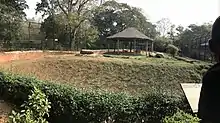Immersion exhibit
An immersion exhibit is a naturalistic zoo environment that gives visitors the sense of being in the animals' habitats. Buildings and barriers are hidden. By recreating sights and other sensorial input from natural environments, immersion exhibits provide an indication about how animals live in the wild.[1]

Immersion Exhibit in Mysuru Zoo
The landscape immersion term and approach were developed in 1975 through the efforts of David Hancocks at Seattle's Woodland Park Zoo.[2] This led to the zoo's ground-breaking gorilla exhibit, which opened in 1978.[3][4] The concept became the industry standard by the 1980s, and has since gained widespread acceptance as the best practice for zoological exhibits.[5]
References
- "What Is an Immersion Exhibit? (St. Louis Zoo definition)". Archived from the original on 2007-09-27. Retrieved 2007-08-10.
- Schaul, Jordan Carlton (2012-03-13), "A Critical Look at the Future of Zoos–An Interview with David Hancocks", National Geographic
- "Inside Out Cage". Retrieved 2011-03-06.
- Coe, Jon Charles; Lee, Gary (1996). "One-Hundred Years of Evolution in Great Ape Facilities in American Zoos: 1896 - 1996" (PDF).
- "Immersion Design". Retrieved 2007-08-10.
This article is issued from Wikipedia. The text is licensed under Creative Commons - Attribution - Sharealike. Additional terms may apply for the media files.